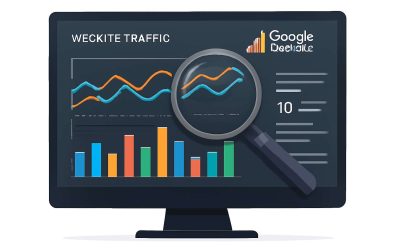Understanding Website Traffic and Its Importance
Defining Website Traffic – What is website traffic and why it matters
Understanding website traffic isn’t just about counting visitors; it’s about uncovering the pulse of your online presence. In South Africa’s bustling digital landscape, knowing how do you get traffic to your website becomes essential for standing out. Traffic reflects the interest, engagement, and trust your brand commands—elements crucial for growth and visibility. When you grasp what drives visitors to your site, you unlock the potential to transform casual browsers into loyal customers.
Website traffic can be defined as the flow of users who land on your pages—each visit a window of opportunity. It’s the lifeblood that sustains your online efforts, influencing your search engine rankings and overall credibility. To truly harness its power, understanding the dynamics behind traffic sources — organic search, referrals, social media, and direct visits — is key. These sources act as gateways, guiding visitors from the digital ether into your carefully crafted content.
- Organic search traffic from search engines like Google
- Referrals from other websites or online platforms
- Direct visits by users typing your URL directly
- Traffic from social media channels and paid campaigns
Knowing how do you get traffic to your website isn’t just a technical challenge; it’s a strategic pursuit that shapes your online destiny. Every visitor counts—each one an opportunity to tell your story and elevate your brand in the competitive South African digital realm.
Types of Website Traffic – Organic, direct, referral, social, paid
Understanding website traffic is an art as much as a science—an intricate dance of shadows and light guiding visitors through your digital domain. In the vast and mysterious expanse of South Africa’s online landscape, knowing how do you get traffic to your website is the key to unlocking unseen opportunities. Traffic isn’t just numbers; it’s the heartbeat of your online presence, whispering tales of interest, trust, and engagement.
There are several distinct streams that feed this vital current. Organic search traffic from engines like Google pulls in visitors who seek your offerings amidst the digital fog. Referral traffic arrives as visitors from other websites or online platforms, drawn by the allure of your content. Direct visits occur when users type your URL directly into their browser, often out of curiosity or loyalty. Meanwhile, social media channels and paid campaigns cast spells that lure targeted audiences into your web of influence.
To truly comprehend how do you get traffic to your website, one must understand these channels—each with its own rhythm and resonance. Recognizing the dance of organic, direct, referral, social, and paid traffic illuminates the path to a thriving online presence—an essential pursuit in the competitive South African digital realm.
The Impact of Traffic on SEO and Business Growth – How increased traffic boosts visibility and conversions
In the grand theater of digital visibility, traffic is the applause that echoes through the corridors of your online presence. Without it, even the most dazzling content remains silent, unheard, and unseen. The question echoes loudly in every aspiring webmaster’s mind: how do you get traffic to your website? The answer lies not merely in numbers but in the symphony of visitors whose interest, trust, and engagement breathe life into your virtual domain.
When traffic flows abundantly, it amplifies your visibility, turning your digital oasis into a beacon for curious souls. This surge of visitors can elevate your site’s ranking, drawing in more organic search traffic, which continues to grow as your content gains authority. Ultimately, increased traffic fuels conversions—transforming casual browsers into loyal customers or clients. In the competitive South African digital landscape, understanding the nuanced dance of traffic channels—organic, referral, social, and paid—becomes essential to unlocking genuine business growth.
Optimizing Your Website for Search Engines
Keyword Research and Implementation – Identifying high-traffic keywords and strategic placement
Understanding how do you get traffic to your website begins with a meticulous approach to keyword research and implementation. In the vast digital landscape, selecting high-traffic keywords is akin to uncovering hidden veins of gold—each one holding the potential to channel a torrent of visitors right to your virtual doorstep. The process demands more than superficial guesswork; it requires a strategic excavation beneath the surface, revealing what your target audience is actively searching for amidst the noise.
Once these keywords are identified, their strategic placement within your content becomes paramount. Incorporate them naturally into headings, meta descriptions, and throughout your copy, ensuring the language flows seamlessly. Consider the psychology of search intent—aligning your keywords with genuine user needs—because this alignment transforms mere traffic into meaningful engagement. When done thoughtfully, this approach does not just improve rankings; it cultivates an authentic connection that encourages visitors to stay longer and explore deeper.
- Identify high-traffic keywords that resonate with your niche.
- Integrate these keywords into your content with a natural, reader-friendly tone.
- Prioritize placement in titles, meta descriptions, and headers for maximum visibility.
In the end, mastering how do you get traffic to your website through refined keyword research and implementation unlocks the door to organic growth, turning passive visitors into active participants in your digital story.
On-Page SEO Techniques – Meta tags, headers, internal linking, and content optimization
In the symphony of digital presence, the melody of search engine optimization plays a pivotal role. To truly understand how do you get traffic to your website, one must master the art of on-page SEO—an intricate dance of meta tags, headers, and content that beckons both algorithms and humans alike. The meta description, like a shimmering signpost, must entice and clarify, whispering to search engines the essence of your page.
Headers act as the guiding landmarks along your content’s journey, breaking the narrative into digestible, SEO-rich segments that elevate user experience. Internal linking weaves a web of interconnectedness, inviting visitors to explore deeper realms within your digital domain, while content optimization ensures every word sings in harmony with your target keywords.

Imagine your website as a grand gallery—each element meticulously curated, each message resonating with purpose. When these techniques are wielded with finesse, they transform mere visitors into loyal explorers—each step drawing closer to understanding, engagement, and conversion. Truly, it’s an art form—one that unlocks the secret of how do you get traffic to your website in a world bursting with noise and distraction.
Technical SEO Best Practices – Site speed, mobile responsiveness, sitemap, and crawlability
In the relentless pursuit of digital visibility, technical SEO acts as the hidden engine propelling your website into the spotlight. When visitors arrive, they expect seamless experiences—fast loading times, mobile responsiveness, and easy navigation. These elements are not mere luxuries; they are the backbone of effective SEO strategy.
Site speed, for instance, can make or break your chances of ranking high on search engines. A delay of just a few seconds can significantly reduce your traffic. Ensuring your website is optimized for mobile devices is equally crucial, especially as more users browse on smartphones. Search engines prioritize mobile-friendly sites, making responsiveness a key player in how do you get traffic to your website.
Implementing a comprehensive sitemap and enhancing crawlability unlocks the full potential of your content. Search engines need clear pathways to index your pages efficiently. To achieve this, consider creating an ordered list of technical priorities:
- Streamline your website’s structure for faster crawling
- Maintain an up-to-date sitemap.xml file
- Remove duplicate content and broken links
- Use robots.txt to guide search engine bots strategically
By mastering these technical SEO best practices, you set the stage for increased visibility. When your website operates like a finely tuned instrument, how do you get traffic to your website becomes less of a mystery—it’s a natural outcome of technical excellence and strategic foresight.
Content Marketing Strategies to Drive Traffic
Creating Valuable and Shareable Content – Blogs, videos, infographics, and more
In the bustling world of digital connectivity, creating valuable and shareable content stands as the cornerstone of any successful SEO strategy. When pondering how do you get traffic to your website, the answer often lies in the quality of your content—think blogs that spark curiosity, videos that entertain and inform, and infographics that distill complex data into visually arresting narratives. Such assets not only attract visitors but encourage them to linger and share, amplifying your reach organically.
One clever approach is to craft content that resonates with your South African audience’s unique interests and cultural nuances. For instance, weaving local success stories or regional insights into your blog posts can foster a sense of community and relevance. To streamline your efforts, consider this simple list of content types that consistently perform well:
- Educational blog articles on trending topics
- Engaging videos showcasing behind-the-scenes insights
- Infographics that simplify intricate data points
- Interactive quizzes or surveys for user engagement
By focusing on creating content that is not only informative but also shareable, you pave a natural path to increased traffic—one that is sustainable and authentic. Remember, in the realm of SEO, content isn’t just king—it’s the entire kingdom, ruling through relevance and relatability.
Content Calendar Planning – Consistent posting schedule for sustained traffic
In the relentless pursuit of digital visibility, a well-crafted content marketing strategy can be the compass guiding your website through the crowded online landscape. One pivotal element often overlooked is the art of content calendar planning. Consistent posting not only sustains your audience’s interest but also signals to search engines that your site is active and authoritative. When pondering how do you get traffic to your website, maintaining a disciplined publishing schedule becomes a cornerstone of long-term success.
By establishing a regular rhythm—be it weekly blog posts, bi-weekly videos, or monthly infographics—you create a predictable flow that keeps visitors coming back for more. To streamline this process, consider developing an editorial calendar that aligns with regional events or trending topics relevant to your South African audience. Such strategic timing can dramatically enhance engagement and sharing, turning your site into a vibrant hub of conversation and discovery.
In the end, the key lies in marrying consistency with relevance, ensuring that every piece of content resonates deeply. When you master this balance, the question of how do you get traffic to your website transforms from an elusive mystery into an achievable reality, driven by purpose and persistence.
Leveraging Evergreen Content – Long-lasting content for ongoing traffic
Harnessing the power of evergreen content is one of the most effective strategies to sustain traffic over time. Unlike fleeting trends, evergreen content remains relevant, continuously attracting visitors long after its initial publication. Think of it as a digital lighthouse—guiding new audiences to your site with timeless value.
By focusing on topics that address fundamental questions or persistent problems within your niche, you create a reservoir of traffic that never runs dry. For example, comprehensive guides on local industry practices or detailed FAQs tailored to South African audiences can keep your website buzzing with activity.
To maximize impact, consider creating a layered content approach—pairing evergreen articles with occasional updates to keep information current. This strategy not only boosts your SEO but also positions your site as a trusted authority. Ultimately, the question of how do you get traffic to your website transforms into an ongoing pursuit of relevance and authority.
Leveraging Social Media Platforms
Choosing the Right Platforms – Facebook, Twitter, LinkedIn, Instagram, and others
Understanding how do you get traffic to your website requires more than just posting content and hoping for the best. Social media platforms have become essential channels for driving targeted traffic, especially when chosen wisely. With over 75% of South Africans active on social media, tapping into these networks offers a direct route to your audience. But not all platforms serve the same purpose—knowing which to leverage is key.
Choosing the right platforms depends heavily on your business goals and target demographic. For professional networking and B2B outreach, LinkedIn holds immense potential. Conversely, Instagram and Facebook excel at visual storytelling and engaging communities. Twitter, with its real-time updates, can be perfect for news-driven content or trending topics. To maximize impact, consider creating tailored content for each platform, ensuring it aligns with user expectations and platform strengths. This strategic approach is crucial for how do you get traffic to your website in a competitive digital landscape.
- Focus on platforms where your ideal audience is most active
- Utilize platform-specific content formats for better engagement
- Maintain consistency in posting to build momentum and trust
Social Sharing and Engagement – Promoting content and building community
Social media isn’t just a digital billboard — it’s a bustling marketplace where content can either go viral or vanish into the ether. Leveraging social media platforms effectively means more than just posting and praying; it’s about fostering genuine engagement and building a community. When you promote your content with purpose, you turn fleeting scrolls into meaningful interactions that drive traffic to your website.
To succeed, tailor your message to each platform’s unique vibe. For example, Instagram is perfect for eye-catching visuals, while LinkedIn demands a more professional tone. Engaging your audience doesn’t stop at posting; encourage shares, comments, and discussions. A lively comment section or a shared infographic can exponentially boost your content’s reach. Remember, the key isn’t just visibility — it’s about creating a ripple effect so your audience becomes advocates.
Here’s a quick rundown of how to turn social sharing into a traffic magnet:
- Share valuable, share-worthy content regularly.
- Use platform-specific formats to maximize engagement.
- Tap into trending hashtags and topics to stay relevant.
Building a community around your brand not only amplifies your message but also establishes trust — an indispensable ingredient in how do you get traffic to your website that sticks around and converts.
Social Media Advertising – Boosting visibility through targeted ads
Harnessing the power of social media advertising can be a game-changer in the quest to understand how do you get traffic to your website. When done right, targeted ads cut through the digital noise, placing your content directly in front of the eyes that matter most. Unlike organic posts, which can be drowned out by algorithms or fleeting trends, paid ads give you precision control over who sees your message. This isn’t about casting a wide net blindly; it’s about strategic placement that delivers real results.
Platforms like Facebook, Instagram, and LinkedIn offer powerful tools to segment your audience based on location, interests, and behaviors. A well-crafted ad campaign can turn casual scrollers into loyal visitors—boosting your website traffic with laser-focused intent. To maximize impact, consider using
- eye-catching visuals
- compelling calls to action
- and retargeting strategies
- Identify authoritative sites within your industry
- Pitch guest posts that add value and showcase expertise
- Include natural backlinks to your site within the content
- Engage with reputable websites through thoughtful guest posts.
- Share your insights on respected industry forums and platforms.
- Develop compelling research, infographics, and case studies that naturally attract backlinks.
- Identifying keywords with high commercial intent
- Creating compelling ad copy that resonates with your target demographic
- Implementing proper bid strategies to optimize your budget
- Continuously monitoring and refining your campaigns based on performance data
- Defining clear demographics and interests
- Creating compelling content that resonates emotionally
- Utilizing precise targeting options for maximum relevance
- First, define your audience segments based on their previous interactions on your site.
- Next, craft personalized ads that speak directly to their interests or pain points.
- Finally, deploy retargeting across platforms like Facebook, Instagram, or LinkedIn to keep your brand top of mind.
- Test different headlines, visuals, or layouts to see what drives more clicks.
- Adjust your content based on user engagement metrics and feedback.
- Refine your targeting parameters within paid campaigns to attract the right visitors.
. This approach ensures your investment translates into measurable growth, giving your website the visibility it needs to thrive.
Building Backlinks and Authority
Guest Posting and Collaborations – Partnering with other websites for backlinks
Building backlinks and establishing authority through guest posting and collaborations is like the secret handshake of SEO success. When you partner with reputable South African websites or niche influencers, you’re essentially borrowing their credibility, which in turn boosts your own. Think of backlinks as digital high-fives—they signal to search engines that your content is worth sharing.
Guest posting not only garners backlinks but also introduces your brand to a wider audience, creating a ripple effect of increased traffic. Collaborations with complementary businesses or content creators amplify your reach and establish your site as a trusted authority. By actively engaging in these partnerships, you position yourself as a key player—making it easier to answer the burning question: how do you get traffic to your website?
Creating Link-Worthy Content – Research, infographics, and case studies
Building backlinks and authority is an art that hinges on creating link-worthy content—content so compelling that others naturally want to reference it. Think research-driven articles, insightful infographics, and thought-provoking case studies. These pieces serve as digital anchors, anchoring your site to valuable industry conversations and establishing credibility.
By investigating what your industry’s authoritative sites already value, you can craft content that resonates and invites sharing. For example, an in-depth case study about local market trends can attract backlinks from prominent South African business portals, elevating your site’s standing.
In the end, the question remains: how do you get traffic to your website? The answer often lies in the content’s ability to stand out—content that is not just informative but genuinely shareable. When your content becomes a magnet for backlinks, your site’s authority grows, and so does your organic reach.
Avoiding Black Hat SEO Tactics – Ensuring sustainable and ethical link building
Building backlinks and establishing authority in the digital realm is a delicate dance—one that hinges on integrity and authenticity. Avoiding black hat SEO tactics is essential for sustainable growth; shortcuts may promise quick wins but often lead to penalties that can cripple your online presence. Instead, focus on creating genuine relationships with industry influencers and producing content that adds real value.
These strategies build a resilient foundation of trust and credibility. Remember, the key question remains—how do you get traffic to your website? The answer is rooted in ethical, high-quality link building—an art that transforms your site into a digital magnet, drawing in visitors and elevating your standing in the vast online landscape.
Utilizing Paid Advertising for Immediate Traffic
Pay-Per-Click (PPC) Campaigns – Google Ads and Bing Ads strategies
When seeking rapid visibility, leveraging paid advertising becomes an indispensable strategy to answer the question: how do you get traffic to your website? Pay-Per-Click (PPC) campaigns, particularly on platforms like Google Ads and Bing Ads, offer an immediate influx of targeted visitors. Unlike organic methods that take time to develop, paid ads provide a shortcut—placing your brand directly in front of potential customers actively searching for your products or services.
Successful PPC campaigns hinge on meticulous keyword selection and strategic ad placement. For example, choosing high-intent keywords can dramatically boost click-through rates, ensuring that your ad spend yields tangible results. Platforms like Google Ads allow you to craft compelling ad copy and customize your audience targeting, while Bing Ads often present a less competitive landscape with cost-effective opportunities. To maximize impact, consider a structured approach such as:
By harnessing these strategies, you can generate immediate traffic, complementing your broader SEO efforts and accelerating your journey toward higher visibility and conversions. Paid advertising is not just a quick fix; it’s a vital component in a holistic approach to building sustainable online presence.
Social Media Ads – Targeted campaigns on Facebook, Instagram, LinkedIn
In the vast digital landscape, where every click is a heartbeat of opportunity, harnessing paid social media advertising can transform your online presence overnight. When pondering how do you get traffic to your website, targeted campaigns on Facebook, Instagram, and LinkedIn emerge as powerful catalysts, reaching audiences precisely where their interests converge with your offerings.
Imagine your message floating like a beacon in a sea of noise—each ad a carefully crafted vessel designed to captivate and convert. Social media ads allow you to segment your audience with surgical precision, ensuring your brand’s voice rises above the din. Whether it’s a carousel of stunning visuals on Instagram or a professional pitch on LinkedIn, these platforms offer an array of tools to elevate your visibility.
To amplify your reach, consider these key elements:
Embracing these strategies, you weave a tapestry of engagement that pulls visitors toward your digital doorstep, bolstering your quest on how do you get traffic to your website with a flourish of organic growth and paid precision combined.
Retargeting and Remarketing – Re-engaging visitors who didn’t convert initially
Sometimes, your website feels like a bustling marketplace, yet visitors seem to pass by with the indifference of a Johannesburg taxi driver stuck in traffic. Paid advertising, particularly retargeting and remarketing, offers an elegant solution—re-engaging those who didn’t convert at first glance. It’s the digital equivalent of leaving a friendly note on a neighbor’s door, reminding them of your presence just when they’re about to forget.
Utilizing paid advertising for immediate traffic isn’t merely about visibility; it’s about precision. Re-engagement campaigns serve an essential role in the broader SEO puzzle, helping you answer the pressing question: how do you get traffic to your website? By targeting visitors who’ve already shown interest, you leverage their initial curiosity into a second, more compelling visit.
Remarketing isn’t just a tactic; it’s an art form—an opportunity to turn fleeting interest into lasting engagement. Because, after all, the secret to sustainable growth lies in reconnecting with those who’ve already crossed your threshold, ensuring they remember your brand long after the initial encounter. How do you get traffic to your website? Sometimes, the answer is simply to invite visitors back for a second, more memorable look.
Analyzing and Refining Your Traffic Strategies
Tracking Website Analytics – Google Analytics and other tools
Tracking website analytics is the unsung hero of any successful traffic strategy. Without it, you’re essentially flying blind—guessing which tactics actually work and which are just fancy paper airplanes. Tools like Google Analytics are your cockpit instruments, revealing where visitors come from, how long they stay, and what makes them click ‘buy now’ or ‘subscribe.’ But don’t stop there; consider using other tools such as Hotjar or SEMrush to gain deeper insights.
To truly refine your approach, analyze the data for patterns—are certain pages attracting more traffic? Which keywords are leading visitors to your site? Once you gather this intel, adjust your strategies accordingly. Think of it as a game of digital chess: every move must be based on data, not guesswork. How do you get traffic to your website? By constantly tracking, analyzing, and refining your tactics—because in the world of SEO, stagnation is the enemy of growth.
Measuring Key Metrics – Traffic sources, bounce rate, average session duration
Understanding how do you get traffic to your website is an intricate dance of metrics and intuition—an ongoing pursuit that demands relentless scrutiny. The core of this process hinges on measuring key metrics that reveal the subtle patterns behind visitor behavior. Traffic sources offer a window into where your audience originates—be it organic search, referral links, social media, or direct visits—each channel whispering its own story of engagement. Bounce rate, the silent sentinel of visitor dissatisfaction, signals whether your content resonates or repels. Meanwhile, average session duration provides a glimpse into the depth of interest, indicating whether your site captivates or merely passes by.
To refine your approach, consider tracking these elements with precision. For example, identify which traffic sources deliver the highest conversion rates or observe if certain pages experience a spike in engagement. This data paints a vivid picture, guiding you toward content that truly connects. For a more granular analysis, tools like Google Analytics or Hotjar can illuminate user pathways and reveal friction points—those moments where visitors drop off or linger. By analyzing these patterns, you can adjust your strategies, optimizing content and user experience.
In the grand chess game of SEO, each move must be informed by data—not guesswork. As you delve into the metrics, it becomes evident that understanding how do you get traffic to your website is an evolving journey—a constant dance of measurement, reflection, and adjustment. When you embrace this iterative process, the growth becomes not just a hope but an inevitable outcome—a testament to the power of strategic refinement rooted in insightful analytics.
A/B Testing and Optimization – Continuous improvement for better results
In the relentless pursuit of digital visibility, the question persists: how do you get traffic to your website in a way that is both strategic and sustainable? The answer lies not in haphazard efforts but in the nuanced art of analysis and refinement. A/B testing emerges as a vital tool, allowing you to compare variations of your content, layout, or calls to action, and discover which version resonates most deeply with your audience. This iterative process transforms guesswork into precision, sharpening your approach with each cycle.
Continuous optimization keeps your strategy alive and adaptable. By examining data from tools like Google Analytics, you can identify friction points and uncover opportunities for growth. For instance, you might notice that a particular landing page underperforms or that certain keywords attract visitors with high engagement. Addressing these insights can dramatically improve your ability to generate targeted traffic—an essential piece of the puzzle in answering the question: how do you get traffic to your website?

To deepen this process, consider employing a structured approach:
By continuously refining your tactics, you forge a path toward more meaningful engagement. The process is not linear but cyclical—each adjustment leads to new insights, which in turn inform the next move. The key is to stay vigilant, to question your assumptions, and to embrace the unpredictable nature of human behavior. The journey of how do you get traffic to your website is a relentless dance, where strategy and psychology intertwine in pursuit of growth.



0 Comments